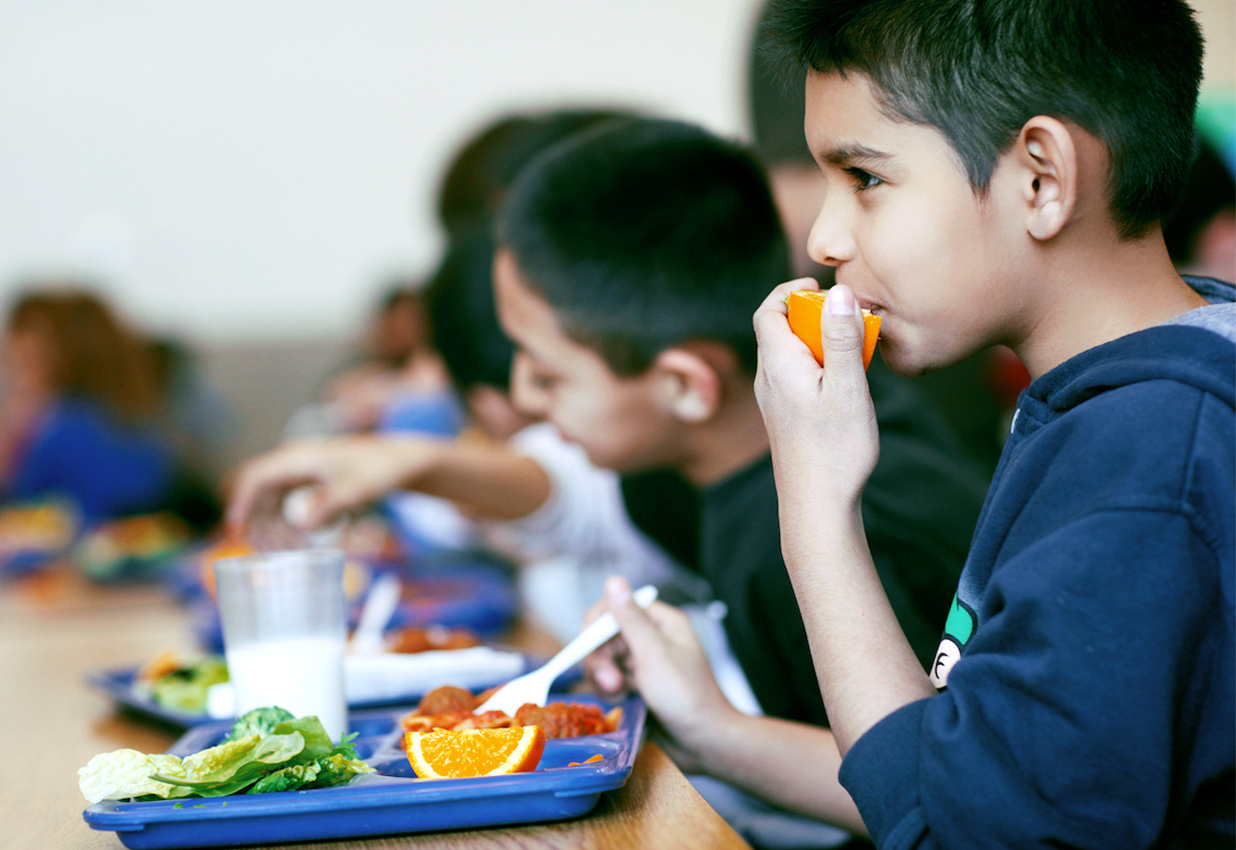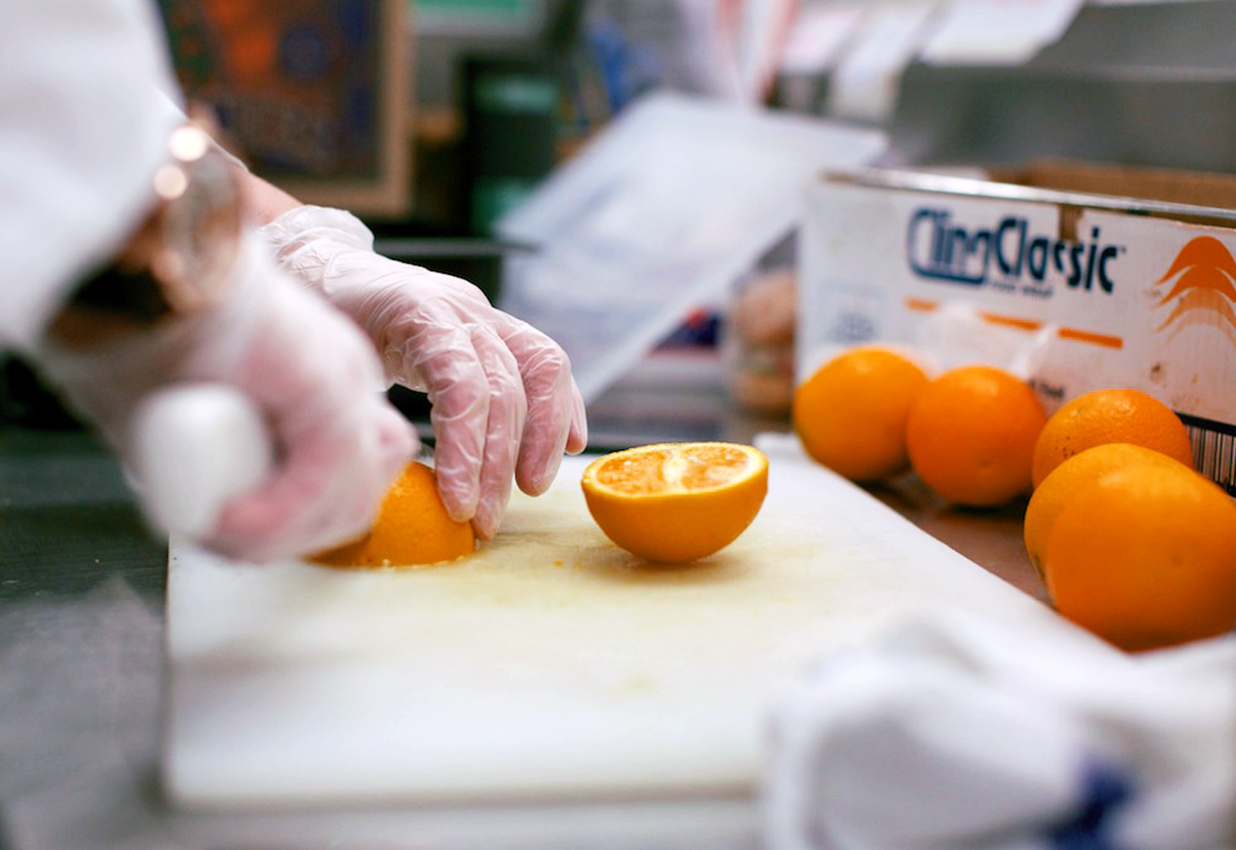
School Breakfast: Operations
In every district, the variety of school building types, age, and access means that there may be as many customizations to breakfast operations as there are schools. The overarching goal is to create efficiency by implementing standard operating procedures and menu cycles, as well as adequate staff training in breakfast procedures and the importance of breakfast. Delivering a cohesive, organized breakfast plan to the district decision makers is imperative to success.

School Breakfast: Operations
In every district, the variety of school building types, age, and access means that there may be as many customizations to breakfast operations as there are schools. The overarching goal is to create efficiency by implementing standard operating procedures and menu cycles, as well as adequate staff training in breakfast procedures and the importance of breakfast. Delivering a cohesive, organized breakfast plan to the district decision makers is imperative to success.
Use our Breakfast Assessment Tool to compile all the key school building information in one place, which will guide you through the decision-making process. For example, based on the projected participation, which sites will require additional refrigeration? How many classrooms, hallways, stairways are there?
Assessing each location’s needs allows you to identify building challenges, schedule issues, and needed infrastructure improvement like electricity for refrigeration. You may have sites where traditional breakfast is the only option. In those cases, are there bus drop-off issues; is the cafeteria space used before school for other programming; and how early is your staff currently arriving at the site? All of this information is critical in developing an effective plan and the eventual success of your breakfast program.
Grants such as FuelUp to Play 60, Action for Healthy Kids, or Kellogg School Breakfast Grants may also provide funds or equipment. Take the time to read through our Alternative Breakfast Equipment Guide, which describes the most common choices for various service models and can help determine district-wide equipment needs based on each school’s criteria.
Depending on the alternative model chosen—Breakfast in the Classroom (BIC) vs. Grab ‘n Go—there are unique factors to consider. When addressing these factors through the equipment guide, keep in mind that creative approaches can provide solutions for a sustainable alternative breakfast model. For example, we’ve seen Red Flyer wagons and suitcase dollies used to move BIC meals. Likewise, Grab ‘n Go setups can vary from folding tables and food service carts to mobile salad bar units or even mechanically cooled and heated service stations that live near key intersections in larger school buildings.
Menus & Food
Take a look at breakfast menus in many districts today, and you’ll see all sorts of packaged pancakes and waffles that are pre-sweetened with maple-flavored corn syrup and sometimes even served on a stick like a corndog. The prevalence of convenience foods is not surprising, especially if you consider these challenges:
- Labor allocated to breakfast is typically small, especially given the restricted budget and bandwidth.
- Budget for breakfast food costs is modest, with most districts trying to keep food cost averages for all meal components under $0.90. Reimbursement for breakfast in school year 2018-19 ranged from $0.31 for non-eligible students to $2.14 for free-eligible students, depending on whether the school qualifies as “severe need.”
- Nutrition requirements like the USDA requirement to serve a cup of fruit or vegetable daily. Juice is also limited under the USDA guidelines and no longer counts as a full serving of fruit. Consequently, many districts are pairing juice with a half cup of fresh, canned, or dried fruit.
- Waste is a big concern and it is a valid one, so efficiency in breakfast becomes paramount.
So with these challenges, how can we offer breakfasts—either in the cafeteria or in the classroom—that are cost-effective, attractive to students, and meet the guidelines?

Traditional Breakfast
For traditional breakfast, reducing waste by limiting over-production is critical to controlling costs. Instead of offering four choices, try offering two: a hot and a cold choice. Cold choices like cereal are helpful, because the product is not wasted. Hot cereal choices like an oatmeal bar with toppings can be cost effective. House-made breakfast burritos are also a cost-effective choice for the cafeteria since they can be assembled on demand to reduce waste. We also see both pre-made and scratch prepared burritos offered in classroom breakfasts. When considering breakfast, each district has to develop a menu that works with the skill set of the team, physical limitations of school buildings, and the taste preferences of the students.

Classroom Breakfast
Classroom breakfast menus are usually simpler. If the breakfast is Grab ’n Go, there may be more than one choice, but delivered breakfast is typically planned as a complete meal with no choice. It may also be presumed to be “offer vs. serve.” If you want to reduce mass-produced ready-to-eat foods, working with local food companies can be an excellent solution. We have seen successful relationships for school-delivered fresh bagels and muffins created to the district’s specifications by local bakeries, and local companies producing breakfast burritos and granolas.
Because breakfast eaten in the classroom is most often served as a complete meal (meaning there’s no offer vs. serve), some districts allow students to save the fruit component to eat later. Depending on the reception of classroom breakfast in your district, this may or may not be an option. However, it’s becoming a popular option, as many teachers acknowledge that students learn better if they aren’t hungry. This also helps reduce waste.

Menus Cycles
Explore breakfast menu cycles developed by us and by districts around the country in our Menu Cycles section.
Creative Serving
Breakfast is often called the “most important meal of the day.” Children need nutritious food in the morning to fuel their bodies, and many studies prove how breakfast affects attention, behavior issues, mental health, and academic performance.
Unfortunately, many kids don’t have access to breakfast at home. With school meals currently free for all kids, you can take full advantage of serving as many students as possible. One of the largest challenges for access to breakfast at school is the serving time. Many families don’t have the ability to get their kids to school early, and kids who ride a bus to school often don’t have the advantage or option of arriving early.
Here are a few ways to serve breakfast in schools:
- Breakfast In the Classroom is one of the most successful ways to feed more vulnerable children. In this method, breakfast is delivered to each classroom and the teacher serves breakfast right after the start of school. Typically a roster is checked off for each student that eats and then the food service staff retrieves the roster along with the remaining breakfast products. Studies have shown that more kids eat breakfast when served this way as it is part of the school day and all students have the ability to receive a meal.
- Breakfast After the Bell is a method that is used in a lot of secondary schools to capture students who aren’t able to come in early to eat before school. In this format, there is usually an extension of time between first and second period. During this time, students can get food from the cafeteria on their way to their next class or they can sit briefly in the cafeteria and eat their meal.
- Grab n Go breakfast is also an effective method and is exactly as described, breakfast served on the go. Generally items are put in a bag or some sort of packaging designed for students to take with them. This is a quick and easy option for busy students and since they are taking the food with them, they have the option of eating when they are hungry or when it best fits into their morning.
- Portable Breakfast Stations are an innovative way to serve breakfast during covid times, taking food directly to kids. Many food service programs have had success by setting up portable breakfast stations outside at the bus drop off area or right inside the door when students arrive in the morning. This saves kids a trip to the cafeteria and is both quick and convenient.
Labor
The impact of breakfast on your current labor model will vary depending upon your operational model, breakfast model, bell schedules, service hours, and historical labor assignments at the sites. Our Meals Per Labor Hour Worksheet is a useful tool to outline your labor baseline. Any time your program changes, it is important to review the impact as part of the planning process.


Labor
The impact of breakfast on your current labor model will vary depending upon your operational model, breakfast model, bell schedules, service hours, and historical labor assignments at the sites. Our Meals Per Labor Hour Worksheet is a useful tool to outline your labor baseline. Any time your program changes, it is important to review the impact as part of the planning process.
Depending on how much labor is attributed to the site before expansion, adding breakfast may or may not require additional labor. Reorganizing start and exit times, adding an hour or two, and occasionally hiring additional personnel are all options but need to be vetted against current labor assignments and expected workload of the expansion.
When calculating a meal equivalent to evaluate Meals Per Labor Hour (MPLH), we typically assign BIC at 2:1, or two breakfasts equal one meal equivalent. This is because it requires more labor if the foodservice staff is solely responsible for pack-out, delivery, pick-up, and data entry. Traditional Breakfast or Grab ‘n Go would be factored at 3:1, three breakfasts equal one meal equivalent. When determining labor requirements, MPLH analysis should be considered in the context of other practical considerations of the site, such as facility limitations and bell schedules that create gaps in service.
SOPs
Standard Operating Procedures
Standard Operating Procedures (SOPs) for breakfast service must be articulated for the particular service model and updated as part of the department’s SOPs. For example, handling leftovers in classroom breakfast and the proper set-up of Grab ‘n Go should each have a SOP.
Food ordering, menu cycles, recipes, production records, and accountability procedures are all part of the school site team’s responsibilities and should all have SOPs. Here is a sample Breakfast SOP from the Wisconsin Department of Public Instruction School Nutrition Team.
Recommended Next Topic: Stakeholder Awareness
Whether introducing breakfast for the first time, expanding as a traditional cafeteria model, or implementing an alternative breakfast model, engaging the school community and building stakeholder awareness is essential. Educating your superintendent, school board, school site administration, teachers, support staff, parents, and students on the need for and benefits of offering breakfast is key to success.
Recommended Next Topic: Stakeholder Awareness
Whether introducing breakfast for the first time, expanding as a traditional cafeteria model, or implementing an alternative breakfast model, engaging the school community and building stakeholder awareness is essential. Educating your superintendent, school board, school site administration, teachers, support staff, parents, and students on the need for and benefits of offering breakfast is key to success.







